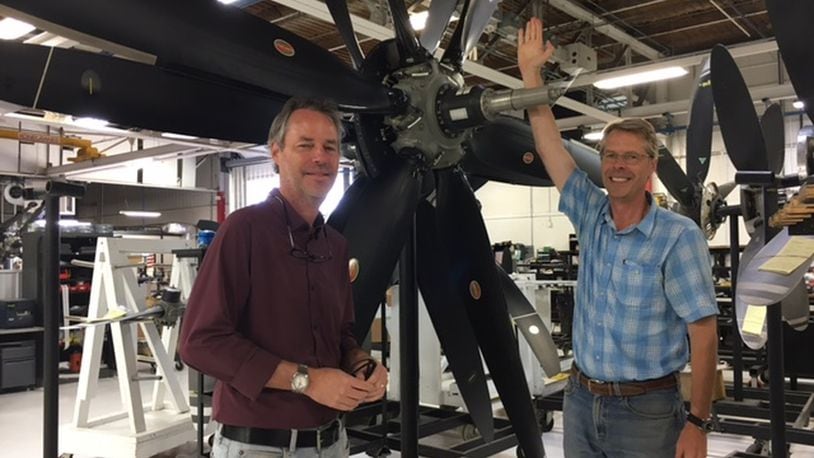Taking a visitor to the company’s propeller manufacturing floor, where the magic happens, Joseph Brown — James’ younger brother and president of Hartzell — sums up the company’s time-tested formula:
RELATED: Wright factory site targeted by aviation alliance
“You have to have the best people; you have to have the best processes; you have to the best technology,” he said. “Other companies may claim that. What’s really hard is making those things work in harmony so the business is always better.”
To make those elements work, Hartzell thrives on being what the Browns call a “small-town” employer.
“We actually have a family with three generations working with us here right now,” Joseph Brown said.
RELATED: Aviation alliance in talks for Wright factory
That kind of “harmony” works well for the business, he said.
“We offer something we think is pretty attractive, and they (employees) offer something that we think is pretty attractive — which is brains, loyalty and commitment,” the younger Brown said. “This company is special because of where it’s located.”
Hartzell is owned by a Piqua-based holding company, Tailwind Technologies, which also owns an Alabama business, Hartzell Engine Technology. Tailwind is essentially a business instrument for buying compatible companies.
RELATED: Kettering-based Reynolds and Reynolds hit with second antitrust suit
Tailwind in its totality saw about $150 million in revenue in 2016, down from a high-water mark of about $200 million, a drop the Browns attributed to the divestment of companies in California and Texas. (James is president of Tailwind while Joseph is its chief operating officer.)
“This is our learning lab,” James Brown said of the Piqua-Hartzell location. “And the things we’ve learned here we’ve used to benefit other businesses that we’ve purchased.”
The company’s centennial celebration so far has been marked with a lunch and concert for employees. Coming up this week is a trip to the EAA Airventure air show in Oshkosh, Wisc. and an air show for employees in Piqua in September.
The company was born in 1917 when Orville Wright — a friend of Robert Hartzell, son of founder George Hartzell —suggested that the Hartzells use walnut wood to build airplane propellers. Soon, with one employee, the older Hartzell was doing just that, according to the company’s history.
Jim Brown Jr. — father of James and Joseph — bought Hartzell from TRW in 1987. The company had 245 local employees at that time, and it has 245 local employees today.
RELATED: Cleveland Clinic-CareSource contract imperiled
But the company is far more productive — and far more efficient — than it was in the late 1980s, the Brown brothers agree.
A key part of that efficiency is finding the right robotics and automation technology and putting that tech to work in a sensible way. James Brown identified Dayton company Gosiger as a key partner in finding the right automation tools.
The robotics have been helpful in handling repetitive tasks where work has to be not just good, but perfect or close to it. And rather than flee that technology, employees actually embraced and helped implement it, the Browns said.
“We didn’t go survey the global market for technology,” Joseph Brown said. “We had employees who picked technologies within the global market and integrated them here.”
And those employees hail from Piqua, Troy, Sidney, Springfield and beyond, all from the Miami Valley.
“They’re home-grown folks,” he said.
Lightweight-but-strong composite blades are one example of what the Browns believe is a problem-solving mentality at Hartzell, giving customers new options. The company will make about 3,000 composite-material propeller blades this year.
“That may not sound like a lot in an automotive town, but in a general aviation town, that’s a lot of volume,” Joseph Brown said.
That mindset doesn’t just embrace technology for technology’s sake, the brothers say. It’s about rallying the workforce around engineering and production applications. These ideas “came from inside.”
“We just figured, if we have the best-brain power, we’re going to win,” he said. “So use it.”
China connection
Hartzell Propeller announced last week it has added a service and support center in China.
Hartzell appointed the Aircraft Repair and Overhaul Plant of Civil Aviation Flight University of China as the service and support center. Located in Guanghan City, CAFUC has 110 employees who perform maintenance, repair and overhaul of aircraft, engines, propellers and components.
The partnership with CAFUC gives Hartzell additional in-country service and support capability, the company said. Hartzell has completed translations of propeller owner manuals into Mandarin for the most popular turboprop and piston-powered aircraft flying in China.
“This latest appointment demonstrates Hartzell Propeller’s ongoing commitment to Chinese owners, operators, maintenance facilities and the continued growth of general aviation in China,” said Weiqing (Max) Wang, Hartzell Propeller managing director for China, based in Shanghai City.
Hartzell Propeller controls about 80 percent of the market for prop-driven planes with engines that produce between 80 and 2,200 horsepower. The company makes about 40 aluminum alloy and composite propellers per day.
Hartzell works closely with about 100 airplane makers and modifiers, according to JJ Frigge, the executive vice president in charge of daily operations at Hartzell. About half of the company’s total sales come from aircraft manufacturers, modifiers and hobbyists. The other half comes from aftermarket parts and service work.
CAFUC is the largest civil aviation university in Asia and the one of the world’s largest flight training institutions. It is responsible for operating and maintaining the largest fleet of propeller driven aircraft in China. CAFUC also has pilot training facilities at five airports located in the Henan and Sichuan Provinces of China.
Reporter Kara Driscoll contributed to this story.
About the Author
